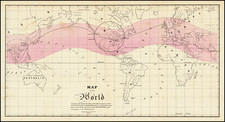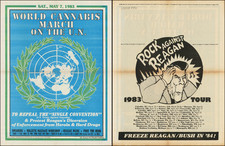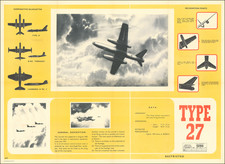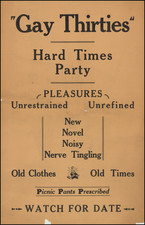The map is entitled Thermal Climate Types of the Earth.
As noted in the memorial below, "His station diagrams of diurnal versus annual temperature regimes were the basis of an insightful characterization of thermal climates" (Thermische Klimatypen der Erde, Petermann's Mitteilungen, Vol. 89, 1943, pp. 81-89
Carl Troll
Few twentieth century geographers have had as much international influence as Carl Troll (1899 -1975), whose field-based contributions concern mountain phenomena on five continents. His research has been applicable to cognate disciplines from biology and geology on the one hand to ethnology and ethno history on the other. Some of the findings from his early fieldwork on South America bridged the epistemological crevasse between the physical and the human.
The following is from the American Geographical Society's Geographical Review, Vol. 66, No. 2 (Apr., 1976), pp. 234-236
CARL TROLL (1899-1975). One of the great figures in geography, Carl Troll, died on July 21, 1975.
Troll exemplified the best of an older generation in the German school; he led the postwar resurgence of geography in Germany; and his international stature was reflected by the presidency of the International Geographical Union at the London meeting of 1964. Like many geographers of his day, Troll received much of his basic training outside the field. Born at Wasserburg (Bavaria) on December 24, i899, he studied botany and geography at Munich, receiving his doctorate in 1922 with a dissertation in plant physiology. His interests in biogeography had come into focus in 1925, when he received faculty status (Habilitation) in geography at Munich. In the classic field tradition, Troll embarked on a three-year study of the Andes in May, 1926, a time when foreign fieldwork was still interdicted for German nationals in most areas other than Latin America. Traveling by mule from Chile to Colombia, he investigated glacial geomorphology, periglacial phenomena, microclimatology, and, above all, vertical ecozonation. In his second major field study he spent a full year, 1933-1934, examining similar phenomena down the backbone of Africa from the Red Sea Hills to the Cape Ranges. Subsequent fieldwork included scientific direction of the Nanga Parbat Expedition to the Himalayas (1937) and exploration of the plant geography of Eritrea and northern Ethiopia (i1938). The unusual scope of his research won recognition in his appointment to Berlin (1930), his designation as editor of the prestigious Koloniale Rundschau (1936), and his being named to the new chair in geography at Bonn (1937), where he remained as director of the Geographical Institute for more than twenty-five years.
In the difficult years that ensued, Troll helped to inspire the passive resistance of the great majority of German geographers that blocked academic recognition of Nazi geopolitics. He spoke out publicly against ethnic relocations in 1942. It appears that he instigated Sven Hedin's dramatic intercession that saved Alfred Philippson from the death camps, and he was instrumental in rescuing Bonn's unique geographical library just before the saturation bomb ing that destroyed the university in October, 1944. Among the ruins, and at his own financial risk, Troll managed to create a new journal, Erdkunde, which first appeared in 1947, marking a rebirth of geography. In its first, lead article (Die geographische Wissenschaft in Deutschland in den Jahren 1933 bis 1945, Erdkunde, Vol. 1, I947, pp. 3-47), Troll explained the nature and contributions of German geography from 1933 to 1945, documenting the breadth and vigor of research and its lack of political overtones. The fact that Karl Haushofer was unable to secure any university appointment underlines the ideological independence gamely preserved by most segments of the academic community in the face of ever-mounting political terror.
Troll was among the first to seek, actively and successfully, to reestablish the international links that had been severed in the late 1930's. His ties with the United States were reconfirmed when he spent a semester as guest professor at the University of Wisconsin in 1954, and the enduring warmth of his Latin American contacts was evident in 1959 when he was invited as keynote lecturer to several Humboldt commemorations in South America. His greatest honor was conferred by the king of Sweden in the form of the Vega Medal, the highest Swedish award next to the Nobel Prize.
Troll's scientific contributions, numbering several hundred papers and five monographs, were equally wide-ranging and trend-setting (see Erdkunde, Vol. 13, 1959, pp. 252-258, and Colloquium Geographicum, Vol. 12, 1970, pp. 18-26, for partial bibliographies). His station diagrams of diurnal versus annual temperature regimes were the basis of an insightful characterization of thermal climates (Thermische Klimatypen der Erde, Petermann's Mitteilungen, Vol. 89, 1943, pp. 81-89; and Climatic Seasons and Climatic Classification, Oriental Geographer, Vol. 2, 1958, pp. 141-165). Observations on soil temperature changes (Die Frostwechselhaufigkeit in den Luft- und Bodenklimaten der Erde, Meteorologische Zeitschrift, Vol. 60, I943, pp. 161-171) were basic to his original contributions to the genesis and classification of stone rings and other patterned ground phenomena (Structure Soils, Solifluction, and Frost Climates of the Earth [Translation 43, U.S. Army Snow, Ice and Permafrost Research Establishment, Wilmette, Ill., 1958]). His ideas on periglacial geomorphology, as synthesized in "Der subnivale oder periglaziale Zyklus der l)enudation" (Erdkunde, Vol. 2, 1948, pp. 1-21), influenced a generation of French, German, and Polish research. In the Andes, Troll developed one of his major theses, that of convergent plant physiognomies among unrelated families as a result of ecological adaptations. Here too he rediscovered Humboldt's model of vertical ecozonation; based on detailed vegetation transects across the mountains at several latitudes, a succession of Troll's papers demonstrated the complexity of three-dimensional ecozonation on a global scale. These contributions found an appropriate summation in "Die tropischen Gebirge" (Bonner Geographische Abhandlungen, Vol. 25, Ferd. l)immlers Verlag, Bonn, 1959). Following his retirement in 1965, and despite recur- rent coronary problems, ITroll remained active in writing, in a variety of international commissions, and as the creative force behind several symposia in biogeography and high- mountain ecology.
Carl Troll was a dynamic and gregarious man, a charismatic teacher eager to share his knowledge, and a humanist as well as a scientist. His passing creates an uncomfortable void, but he leaves a lasting legacy of scholarship and intellectual inspiration.
August Heinrich Petermann (1822-1878) is a renowned German cartographer of the nineteenth century. Petermann studied cartography at the Geographical Art-School in Potsdam before traveling to Edinburgh to work with Dr. A. Keith Johnston on an English edition of Berghaus’ Physical Atlas. Two years later he moved to London, where he made maps and advised exploratory expeditions as they set off to explore the interior of Africa and the Arctic.
In 1854, Petermann returned to Germany to be Director of the Geographical Institute of Justus Perthes in Gotha. There, he was the editor of the Geographische Mittheilungen and Stieler’s Handatlas. The Royal Geographical Society of London awarded him their Gold Medal in 1860. He continued his interest in exploration in Germany, fundraising for the German Exploring Expeditions of 1868 and 1869-70, which sought an open Arctic sea. Tragically, he committed suicide in 1878.













![Asia Secunda Pars Terrae in Forma Pegasi [Asia in the Form of Pegasus]](https://storage.googleapis.com/raremaps/img/small/94173.jpg)

![Marine, Pavillions [Nautical Flags]](https://storage.googleapis.com/raremaps/img/small/81797.jpg)
